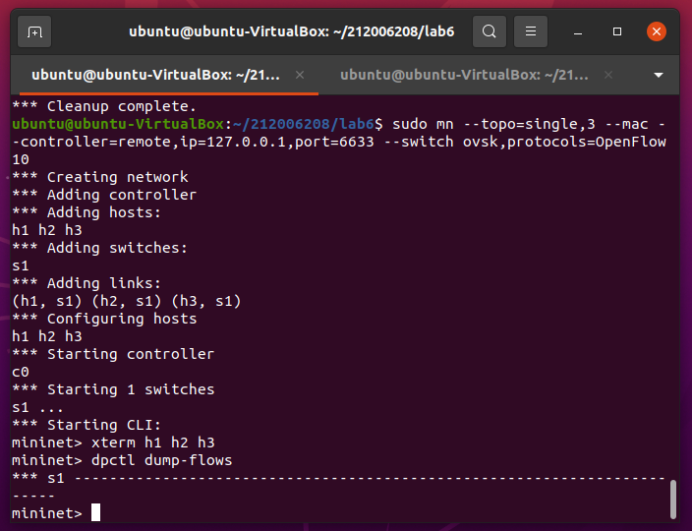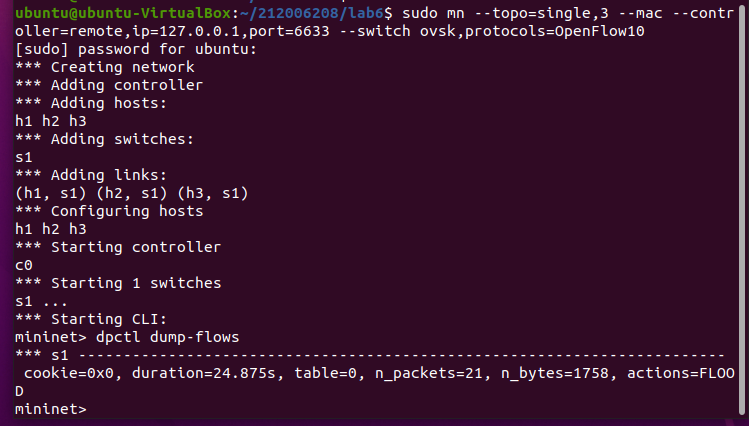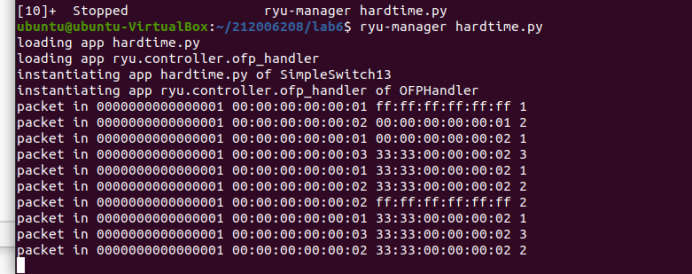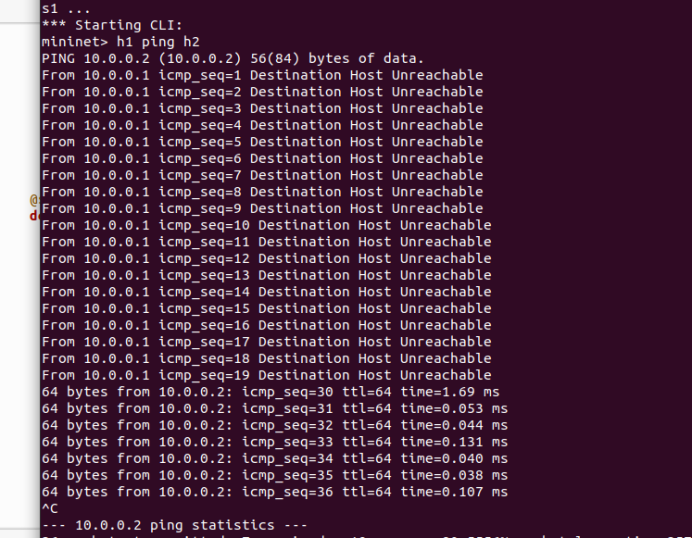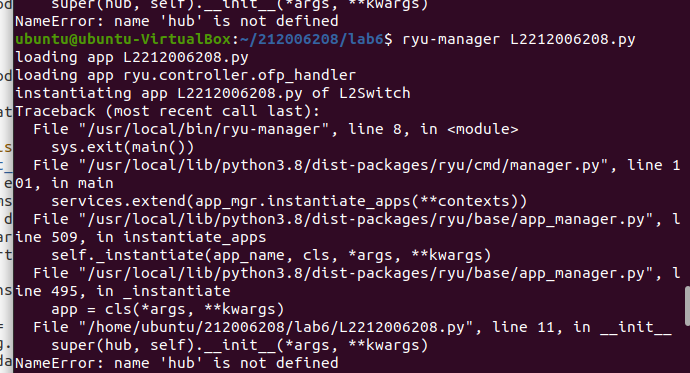一、基礎要求
- L2Switch是無法查看流表的,但是POX的Hub是可以查看流表的
L2Switch下查看流表:
![]()
pox的hub下查看流表:
./pox.py log.level --DEBUG forwarding.hub
![]()
- 修改之后的L2212006208.py代碼:
from ryu.base import app_manager
from ryu.controller import ofp_event
from ryu.controller.handler import MAIN_DISPATCHER
from ryu.controller.handler import CONFIG_DISPATCHER, MAIN_DISPATCHER
from ryu.controller.handler import set_ev_cls
from ryu.ofproto import ofproto_v1_3
class L2Switch(app_manager.RyuApp):
OFP_VERSIONS = [ofproto_v1_3.OFP_VERSION]
def __init__(self, *args, **kwargs):
super(L2Switch, self).__init__(*args, **kwargs)
@set_ev_cls(ofp_event.EventOFPSwitchFeatures, CONFIG_DISPATCHER)
def switch_features_handler(self, ev):
datapath = ev.msg.datapath
ofproto = datapath.ofproto
parser = datapath.ofproto_parser
# install table-miss flow entry
#
# We specify NO BUFFER to max_len of the output action due to
# OVS bug. At this moment, if we specify a lesser number, e.g.,
# 128, OVS will send Packet-In with invalid buffer_id and
# truncated packet data. In that case, we cannot output packets
# correctly. The bug has been fixed in OVS v2.1.0.
match = parser.OFPMatch()
actions = [parser.OFPActionOutput(ofproto.OFPP_CONTROLLER,
ofproto.OFPCML_NO_BUFFER)]
self.add_flow(datapath, 0, match, actions)
def add_flow(self, datapath, priority, match, actions, buffer_id=None):
ofproto = datapath.ofproto
parser = datapath.ofproto_parser
inst = [parser.OFPInstructionActions(ofproto.OFPIT_APPLY_ACTIONS,
actions)]
if buffer_id:
mod = parser.OFPFlowMod(datapath=datapath, buffer_id=buffer_id,
priority=priority, match=match,
instructions=inst)
else:
mod = parser.OFPFlowMod(datapath=datapath, priority=priority,
match=match, instructions=inst)
datapath.send_msg(mod)
@set_ev_cls(ofp_event.EventOFPPacketIn, MAIN_DISPATCHER)
def packet_in_handler(self, ev):
msg = ev.msg
dp = msg.datapath
ofp = dp.ofproto
ofp_parser = dp.ofproto_parser
in_port = msg.match['in_port']
actions = [ofp_parser.OFPActionOutput(ofp.OFPP_FLOOD)]
data = None
if msg.buffer_id == ofp.OFP_NO_BUFFER:
data = msg.data
out = ofp_parser.OFPPacketOut(
datapath=dp, buffer_id=msg.buffer_id, in_port=in_port,
actions=actions, data = data)
dp.send_msg(out)
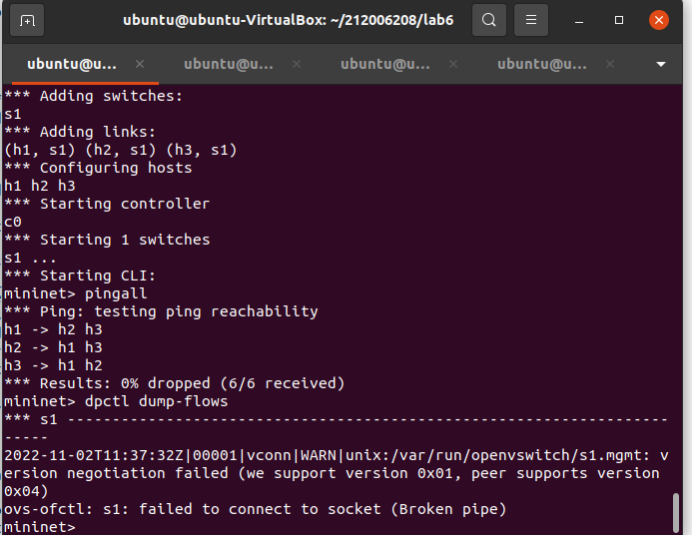
二、進階要求
- 回答問題:
a)代碼當中的mac_to_port的作用是什么?
mac地址到交換機端口的一個映射
b) simple_switch和simple_switch_13在dpid的輸出上有何不同?
simple_switch:
dpid = datapath.id
self.mac_to_port.setdefault(dpid, {})
直接輸出dpid
simple_switch_13:
dpid = format(datapath.id, "d").zfill(16)
self.mac_to_port.setdefault(dpid, {})
用0在dpid前填充,直到dpid總長度達到16位。
c) 相比simple_switch,simple_switch_13增加的switch_feature_handler實現了什么功能?
實現了交換機以特性應答消息去響應特性請求這一功能
d) simple_switch_13是如何實現流規則下發的?
當接收到packetin事件后,首先獲取交換機信息,包學習,協議信息,以太網信息等。如果以太網類型是LLDP類型,就不進行任何處理。若不是,則獲取源端口、目的端口和交換機id,先學習源地址對應的交換機入端口,再查看是否學習了目的mac地址,若沒有則進行洪泛轉發,但若學習過該mac地址,則查看是否有buffer_id,若有,先在添加流動作時加上buffer_id,再向交換機發送流表。
e) switch_features_handler和_packet_in_handler兩個事件在發送流規則的優先級上有何不同?
switch_features_handler下發流表的優先級高于_packet_in_handler
- 代碼注釋
# Copyright (C) 2011 Nippon Telegraph and Telephone Corporation.
#
# Licensed under the Apache License, Version 2.0 (the "License");
# you may not use this file except in compliance with the License.
# You may obtain a copy of the License at
#
# http://www.apache.org/licenses/LICENSE-2.0
#
# Unless required by applicable law or agreed to in writing, software
# distributed under the License is distributed on an "AS IS" BASIS,
# WITHOUT WARRANTIES OR CONDITIONS OF ANY KIND, either express or
# implied.
# See the License for the specific language governing permissions and
# limitations under the License.
from ryu.base import app_manager
from ryu.controller import ofp_event
from ryu.controller.handler import CONFIG_DISPATCHER, MAIN_DISPATCHER
from ryu.controller.handler import set_ev_cls
from ryu.ofproto import ofproto_v1_3
from ryu.lib.packet import packet
from ryu.lib.packet import ethernet
from ryu.lib.packet import ether_types
class SimpleSwitch13(app_manager.RyuApp):
OFP_VERSIONS = [ofproto_v1_3.OFP_VERSION] #定義openflow的版本為1.3
def __init__(self, *args, **kwargs):
super(SimpleSwitch13, self).__init__(*args, **kwargs)
self.mac_to_port = {}
@set_ev_cls(ofp_event.EventOFPSwitchFeatures, CONFIG_DISPATCHER) # 處理EventOFPSwitchFeatures事件
def switch_features_handler(self, ev):
datapath = ev.msg.datapath #ev.msg 是用來存儲對應事件的 OpenFlow 消息類別實體
ofproto = datapath.ofproto # ofproto表示使用的OpenFlow版本所對應的ryu.ofproto.ofproto_v1_3
parser = datapath.ofproto_parser
# install table-miss flow entry
#
# We specify NO BUFFER to max_len of the output action due to
# OVS bug. At this moment, if we specify a lesser number, e.g.,
# 128, OVS will send Packet-In with invalid buffer_id and
# truncated packet data. In that case, we cannot output packets
# correctly. The bug has been fixed in OVS v2.1.0.
match = parser.OFPMatch()
actions = [parser.OFPActionOutput(ofproto.OFPP_CONTROLLER,
ofproto.OFPCML_NO_BUFFER)]
self.add_flow(datapath, 0, match, actions)
def add_flow(self, datapath, priority, match, actions, buffer_id=None): #添加流表
ofproto = datapath.ofproto
parser = datapath.ofproto_parser #獲取交換機信息
inst = [parser.OFPInstructionActions(ofproto.OFPIT_APPLY_ACTIONS,
actions)] #包裝action
#判斷是否有buffer_id,生成相應的mod對象
if buffer_id:
mod = parser.OFPFlowMod(datapath=datapath, buffer_id=buffer_id,
priority=priority, match=match,
instructions=inst)
else:
mod = parser.OFPFlowMod(datapath=datapath, priority=priority,
match=match, instructions=inst)
#發送mod
datapath.send_msg(mod)
# 處理 packet in 事件
@set_ev_cls(ofp_event.EventOFPPacketIn, MAIN_DISPATCHER)
def _packet_in_handler(self, ev):
# If you hit this you might want to increase
# the "miss_send_length" of your switch
if ev.msg.msg_len < ev.msg.total_len:
self.logger.debug("packet truncated: only %s of %s bytes",
ev.msg.msg_len, ev.msg.total_len)
# 獲取包信息,交換機信息,協議等等
msg = ev.msg
datapath = msg.datapath
ofproto = datapath.ofproto
parser = datapath.ofproto_parser
in_port = msg.match['in_port']
pkt = packet.Packet(msg.data)
eth = pkt.get_protocols(ethernet.ethernet)[0]
if eth.ethertype == ether_types.ETH_TYPE_LLDP:
# ignore lldp packet
return
dst = eth.dst
src = eth.src# 獲取源端口,目的端口
dpid = format(datapath.id, "d").zfill(16)
self.mac_to_port.setdefault(dpid, {})
self.logger.info("packet in %s %s %s %s", dpid, src, dst, in_port) #dpid是交換機的id,src是數據包的源mac地址,in_port是交換機接受到包的端口
# learn a mac address to avoid FLOOD next time.
self.mac_to_port[dpid][src] = in_port # 查看是否已經學習過該目的mac地址,如果已經學習到,則向交換機下發流表,并讓交換機向相應端口轉發包
if dst in self.mac_to_port[dpid]:
out_port = self.mac_to_port[dpid][dst]
else: #沒有就進行洪泛
out_port = ofproto.OFPP_FLOOD
actions = [parser.OFPActionOutput(out_port)]
# 下發流表處理后續包,不再觸發PACKETIN事件
# install a flow to avoid packet_in next time
if out_port != ofproto.OFPP_FLOOD:
match = parser.OFPMatch(in_port=in_port, eth_dst=dst, eth_src=src)
# verify if we have a valid buffer_id, if yes avoid to send both
# flow_mod & packet_out
#buffer_id不為None,控制器只需下發流表的命令,交換機增加了流表項后,位于緩沖區的數據包,會自動轉發出去。
if msg.buffer_id != ofproto.OFP_NO_BUFFER:
self.add_flow(datapath, 1, match, actions, msg.buffer_id)
return
else:
self.add_flow(datapath, 1, match, actions)
data = None #buffer_id為None,則控制器不僅要更改交換機的流表項,還要把數據包的信息傳給交換機,讓交換機把數據包轉發出去。
if msg.buffer_id == ofproto.OFP_NO_BUFFER:
data = msg.data
out = parser.OFPPacketOut(datapath=datapath, buffer_id=msg.buffer_id,
in_port=in_port, actions=actions, data=data)
datapath.send_msg(out) #發送流表
- 編程實現和ODL實驗的一樣的硬超時功能。
![]()
![]()
# Copyright (C) 2011 Nippon Telegraph and Telephone Corporation.
#
# Licensed under the Apache License, Version 2.0 (the "License");
# you may not use this file except in compliance with the License.
# You may obtain a copy of the License at
#
# http://www.apache.org/licenses/LICENSE-2.0
#
# Unless required by applicable law or agreed to in writing, software
# distributed under the License is distributed on an "AS IS" BASIS,
# WITHOUT WARRANTIES OR CONDITIONS OF ANY KIND, either express or
# implied.
# See the License for the specific language governing permissions and
# limitations under the License.
from ryu.base import app_manager
from ryu.controller import ofp_event
from ryu.controller.handler import CONFIG_DISPATCHER, MAIN_DISPATCHER
from ryu.controller.handler import set_ev_cls
from ryu.ofproto import ofproto_v1_3
from ryu.lib.packet import packet
from ryu.lib.packet import ethernet
from ryu.lib.packet import ether_types
class SimpleSwitch13(app_manager.RyuApp):
OFP_VERSIONS = [ofproto_v1_3.OFP_VERSION]
def __init__(self, *args, **kwargs):
super(SimpleSwitch13, self).__init__(*args, **kwargs)
self.mac_to_port = {}
@set_ev_cls(ofp_event.EventOFPSwitchFeatures, CONFIG_DISPATCHER)
def switch_features_handler(self, ev):
datapath = ev.msg.datapath
ofproto = datapath.ofproto
parser = datapath.ofproto_parser
# install table-miss flow entry
#
# We specify NO BUFFER to max_len of the output action due to
# OVS bug. At this moment, if we specify a lesser number, e.g.,
# 128, OVS will send Packet-In with invalid buffer_id and
# truncated packet data. In that case, we cannot output packets
# correctly. The bug has been fixed in OVS v2.1.0.
match = parser.OFPMatch()
actions = [parser.OFPActionOutput(ofproto.OFPP_CONTROLLER,
ofproto.OFPCML_NO_BUFFER)]
self.add_flow(datapath, 0, match, actions)
#添加流表函數(執行add_flow()方法以發送flow mod消息)這里加了一個hardtime參數
def add_flow(self, datapath, priority, match, actions, buffer_id=None, hard_timeout=0):
ofproto = datapath.ofproto
parser = datapath.ofproto_parser
inst = [parser.OFPInstructionActions(ofproto.OFPIT_APPLY_ACTIONS,
actions)]
if buffer_id:
mod = parser.OFPFlowMod(datapath=datapath, buffer_id=buffer_id,
priority=priority, match=match,
instructions=inst, hard_timeout=hard_timeout)
else:
mod = parser.OFPFlowMod(datapath=datapath, priority=priority,
match=match, instructions=inst, hard_timeout=hard_timeout)
datapath.send_msg(mod)
@set_ev_cls(ofp_event.EventOFPPacketIn, MAIN_DISPATCHER)
def _packet_in_handler(self, ev):
# If you hit this you might want to increase
# the "miss_send_length" of your switch
if ev.msg.msg_len < ev.msg.total_len:
self.logger.debug("packet truncated: only %s of %s bytes",
ev.msg.msg_len, ev.msg.total_len)
msg = ev.msg
datapath = msg.datapath
ofproto = datapath.ofproto
parser = datapath.ofproto_parser
in_port = msg.match['in_port']
pkt = packet.Packet(msg.data)
eth = pkt.get_protocols(ethernet.ethernet)[0]
if eth.ethertype == ether_types.ETH_TYPE_LLDP:
# ignore lldp packet
return
dst = eth.dst
src = eth.src
dpid = format(datapath.id, "d").zfill(16)
self.mac_to_port.setdefault(dpid, {})
self.logger.info("packet in %s %s %s %s", dpid, src, dst, in_port)
# learn a mac address to avoid FLOOD next time.
self.mac_to_port[dpid][src] = in_port
if dst in self.mac_to_port[dpid]:
out_port = self.mac_to_port[dpid][dst]
else:
out_port = ofproto.OFPP_FLOOD
actions = [parser.OFPActionOutput(out_port)]\
actions_timeout=[]
# install a flow to avoid packet_in next time
if out_port != ofproto.OFPP_FLOOD:
match = parser.OFPMatch(in_port=in_port, eth_dst=dst, eth_src=src)
# verify if we have a valid buffer_id, if yes avoid to send both
# flow_mod & packet_out
hard_timeout=10 #設置硬超時時間為10s
#buffer_id不為None,控制器只需下發流表的命令同時實現硬超時功能,交換機增加了流表項后,位于緩沖區的數據包,會自動轉發出去。
#此條中帶有硬超時功能的優先級為2
if msg.buffer_id != ofproto.OFP_NO_BUFFER:
self.add_flow(datapath, 2, match,actions_timeout, msg.buffer_id,hard_timeout=10)
self.add_flow(datapath, 1, match, actions, msg.buffer_id)
return
#buffer_id為None,則控制器不僅要更改交換機的流表項,還要把數據包的信息傳給交換機,讓交換機把數據包轉發出去。
#此條中帶有硬超時功能的優先級為2
else:
self.add_flow(datapath, 2, match, actions_timeout, hard_timeout=10)
self.add_flow(datapath, 1, match, actions)
data = None
if msg.buffer_id == ofproto.OFP_NO_BUFFER:
data = msg.data
out = parser.OFPPacketOut(datapath=datapath, buffer_id=msg.buffer_id,
in_port=in_port, actions=actions, data=data)
datapath.send_msg(out)
- 個人總結
本次實驗主要是通過閱讀ryu的相關文章以及查看了解ryu的代碼,來了解ryu控制器的工作原理,能夠獨立部署ryu控制器,理解ryu控制器再軟件定義網絡中的一些原理,并且區分ryu和pox的Hub模板之間的區別,在這次實驗中,讓我體會到了python文件縮進的重要性,只要一行的縮進不對就會導致代碼不能正確運行。在進階實驗中,了解了代碼的含義并且對代碼進行了注釋,有了更加深刻的印象,并且實現了硬超時的功能。
問題一:
![]()
解決辦法:需要將openflow的版本改成1.3,并且是要先運行ryu,再創建拓撲才是可以
![]()
問題二:
![]()
解決辦法:因為縮進的問題導致運行錯誤


